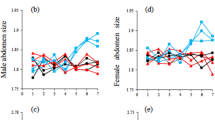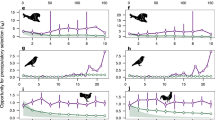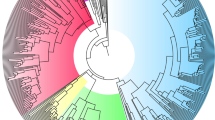Abstract
There is abundant evidence for the existence of marked mate preferences in natural populations, but the occurrence of within-population variation in mate preferences has received little attention1,2,3 and is often regarded as nonadaptive deviation from the optimal norm2,3. Here we show experimentally that the preference of female collared flycatchers Ficedula albicollis for male forehead patch size, a sexually selected trait4,5,6, varies with the time of breeding, an environmental factor with strong effects on reproductive success. Contrary to expectations based on time-constrained choice models7,8, only late-breeding females prefer males with a large patch size. The variation in mate preference matches a seasonal change in female reproductive success: long-term data reveal a positive relationship between female reproductive success and male patch size exclusively in late breeders. In addition, female reproductive effort, as assessed by clutch size, appears to be adjusted relative to both timing of breeding and male phenotype. We conclude that not only can mate preferences display adaptive plasticity within populations, but this plasticity can also be linked to differences in reproductive investment.
This is a preview of subscription content, access via your institution
Access options
Subscribe to this journal
Receive 51 print issues and online access
$199.00 per year
only $3.90 per issue
Buy this article
- Purchase on Springer Link
- Instant access to full article PDF
Prices may be subject to local taxes which are calculated during checkout



Similar content being viewed by others
References
Andersson, M. Sexual Selection. (Princeton Univ. Press, Princeton, 1994).
Jennions, M. D., Petrie, M. Variation in mate choice and mating preferences: a review of causes and consequences. Biol. Rev. 72, 283–327 (1997).
Widemo, F. & Sæther, S. A. Beauty is in the eye of the beholder: causes and consequences of variation in mating preferences. Trends Ecol. Evol. 14, 26– 31 (1999).
Pärt, T. & Qvarnström, A. Badge size in collared flycatchers predicts the outcome of male competition over territories. Anim. Behav. 54, 893–899 ( 1997).
Gustafsson, L., Qvarnström, A. & Sheldon, B. C. Trade-offs between life-history traits and a secondary sexual character in male collared flycatchers. Nature 375, 311–313 (1995).
Sheldon, B. C. & Ellegren, H. Sexual selection resulting from extra-pair paternity in collared flycatchers. Anim. Behav. 57, 285–298 (1999).
Real, L. Search theory and mate choice. 1. Models of single-sex discrimination. Am. Nat. 136, 376–405 ( 1990).
Gibson, R. M. & Langen, T. A. How do animals choose their mates? Trends Ecol. Evol. 11, 468– 470 (1996).
Gustafsson, L. in Lifetime Reproduction in Birds (ed. Newton, I.) 75– 88 (Academic, London, 1989).
Wiggins, D. A., Pärt, T. & Gustafsson, L. Seasonal decline in collared flycatcher Ficedula albicollis reproductive success: an experimental approach. Oikos 70, 359–364 ( 1994).
Qvarnström, A. Experimentally increased badge size increases male competition and reduces male parental care in the collared flycatcher. Proc. R. Soc. Lond. B 264, 1225–1231 ( 1997).
Qvarnström, A. Different reproductive tactics in male collared flycatchers signalled by size of secondary sexual character. Proc. R. Soc. Lond. B 266, 2089–2093 (1999).
Kokko, H. Should advertising parental care be honest? Proc. R. Soc. Lond. B 265, 1871–1878 ( 1998).
Crick, H. Q. P., Gibbons, B. W. & Magrath, R. D. Seasonal changes in clutch size in British birds. J. Anim. Ecol. 62, 263– 273 (1993).
Sheldon, B. C., Merilä, J., Qvarnström, A., Gustafsson, L. & Ellegren, H. Paternal genetic contribution to offspring condition predicted by size of male sexual ornament. Proc. R. Soc. Lond. B 264, 297–302 (1997).
Qvarnström, A. Genotype-by-environment interactions in the determination of the size of a secondary sexual character in the collared flycatcher (Ficedula albicollis ). Evolution 53, 1564– 1572 (1999).
Bakker, T. C. M., Künzler, R. & Mazzi, D. Condition-related mate choice in sticklebacks. Nature 401, 234 (1999).
Griffith, S. C., Owens, I. P. F. & Burke, T. Female choice and annual reproductive success favour less-ornamented male house sparrows. Proc. R. Soc. Lond. B 266, 765–770 (1999).
Pärt. T. & Gustafsson, L. Breeding dispersal in the collared flycatcher (Ficedula albicollis): possible causes and reproductive consequences. J. Anim. Ecol. 58, 305– 320 (1989).
Gustafsson, L. & Sutherland, W. J. The costs of reproduction in the collared flycatcher. Nature 335, 813–815 (1988).
Gustafsson, L. & Pärt, T. Acceleration of senescence in the collared flycatcher Ficedula albicollis by reproductive costs. Nature 347, 279– 281 (1990)
Acknowledgements
We thank I. Ahnesjö, D. Irwin, S. Griffith, L. Gustafsson, C. Hemborg, H. Kokko, T. Price, S. Ulfstrand and F. Widemo for their comments on the manuscript. Financial support was obtained from the Royal Swedish Academy of Sciences, Stiftelsen Zoologisk Forskning (Uppsala University), the Swedish Foundation for International Cooperation in Research and Higher Education (STINT), the Fulbright Commission (A.Q.) the Swedish Natural Sciences Research Council (B.C.S., T.P.) and a Royal Society University Research Fellowship (B.C.S.).
Author information
Authors and Affiliations
Corresponding author
Rights and permissions
About this article
Cite this article
Qvarnström, A., Pärt, T. & Sheldon, B. Adaptive plasticity in mate preference linked to differences in reproductive effort. Nature 405, 344–347 (2000). https://doi.org/10.1038/35012605
Received:
Accepted:
Issue Date:
DOI: https://doi.org/10.1038/35012605
This article is cited by
-
The influence of immune challenges on the mean and variance in reproductive investment: a meta-analysis of the terminal investment hypothesis
BMC Biology (2023)
-
Common cuckoo females may escape male sexual harassment by color polymorphism
Scientific Reports (2019)
-
Environmental heterogeneity alters mate choice behavior for multimodal signals
Behavioral Ecology and Sociobiology (2019)
-
Transgenerational effects of maternal sexual interactions in seed beetles
Heredity (2018)
-
Experimental manipulation of a signal trait reveals complex phenotype-behaviour coordination
Scientific Reports (2018)
Comments
By submitting a comment you agree to abide by our Terms and Community Guidelines. If you find something abusive or that does not comply with our terms or guidelines please flag it as inappropriate.



